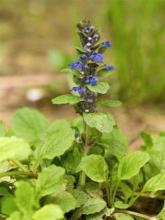A perennial herb found primarily in Central Asia, Ajuga turkestanica is known to contain several bioactive compounds and has been used in traditional medicine to treat heart disease, and stomach and muscle aches (Chem. Nat. Compd. 1998;34:150-4; Chem. Nat. Compd. 2004;40:85-6). It is one of the many species of Ajuga gaining attention for exhibiting medicinal properties with the potential for commercial applications (Phytochem. Lett. 2008;1:81-4).
Clerodane diterpenes, recognized sources of antimicrobial, antiviral, antitumor, antibiotic, and amoebicidal activities (Phytochem. Rev. 2008;7:25-49), are among the three classes of potentially bioactive compounds, along with phytoecdysteroids and iridoid glycosides found in the Ajuga genus (Phytochem. Lett. 2008;1:81-4). Phytoecdysteroids are known to display significant physiological activities in insects and mammals; and iridoid glycosides, especially abundant in A. decumbens, have exhibited anticancer activity (Cancer Lett. 2000;157:87-92).
A. turkestanica reportedly contains several phytoecdysteroids (turkesterone, 20-hydroxyecdysone, cyasterone, cyasterone 22-acetate, ajugalactone, ajugasterone B, alpha-ecdysone, and ecdysone 2,3-monoacetonide), as well as the iridoids harpagide and harpagide 8-acetate (Chem. Nat. Compd. 2005;41:361-9; Chem. Nat. Compd. 1978;14:175-8; Chem. Nat. Compd. 1975;11:484-7; Chem. Nat. Compd. 1973;9:125-6; Chem. Nat. Compd. 1971;7:520; Phytochem. Lett. 2008;1:81-4).
Aquaporins
Aquaporins (AQPs) are integral membrane proteins that facilitate water transport in several organs, including the skin, brain, eyes, and digestive tract, as well as in the renal tubules. Thirteen isoforms of aquaporins (AQPs 0-12) are found in mammals. Of these, there are two functional subtype classifications: AQPs 1, 2, 4, 5, and 8 conduct only water, and AQPs 3, 7, 9, and 10 transport water and other substances including glycerol and urea (Prog. Histochem. Cytochem. 2004;39:1-83). AQP-3, permeable to water and glycerol, is the main water channel in human epidermis. Glycerol acts as an endogenous humectant, thereby facilitating hydration of the stratum corneum (SC) (J. Invest. Dermatol. 2005;125:288-93).
Defects in AQP-3 in mice models have been demonstrated to lead to epidermal xerosis and to reductions in SC hydration and epidermal glycerol content, followed by diminished elasticity and impaired skin barrier recovery (J. Biol. Chem. 2002;277:46616-21; Proc. Natl. Acad. Sci. 2003;100:7360-5). Such findings underscore the important role of glycerol in cutaneous hydration. Significantly, AQPs, particularly AQP-3, contribute to the transport of water, glycerol, and solutes between keratinocytes.
Dumas et al. note that the role of AQPs in hydrating the living layers of the epidermis where keratinocyte differentiation occurs and in barrier development and recovery suggests that they are significant protein targets for improving the quality and resistance of the skin surface, as well as ameliorating aging- and UV-induced xerosis (J. Drugs Dermatol. 2007;6(6 Suppl):s20-4).
A. turkestanica and Aquaporins
Patented extracts of A. turkestanica have been shown to contain sufficient ecdysteroids and other active ingredients to improve the differentiation of keratinocytes, thus facilitating skin hydration and yielding antiaging effects (U.S. Patent 7,060,693 B1, June 13, 2006). The patent inventors Dumas et al. observed that the extracts are especially effective in regulating epidermal water transport, achieving improved hydration of the basal layer by working in concert with or enhancing AQP-3 (Cosmet. Toil. 2008;123:22-7).
In 2007, Dumas et al. conducted in vitro and in vivo studies of active ingredients capable of raising AQP-3 levels to enhance hydration in human skin keratinocytes, with the understanding that improving hydration in keratinocytes would ultimately improve epidermal hydration (Eur. J. Dermatol. 2002;12:XXV-XXVI). They used an ethanol/water (70/30 v/v) extract of A. turkestanica as the hydrating agent (2.5 mcg/mL), and found that after 17 days of in vitro treatment every 2 days in human reconstructed epidermis, AQP-3 expression measured at the protein level was significantly elevated. Increased epidermal proliferation and differentiation were also noted. Electron microscopy showed a significantly thicker, compact SC and more clearly differentiated desmosomes. Constituents of the A. turkestanica extract revealed by chemical analysis included iridoids (chiefly harpagoside and 8-O-acetylharpagoside), ajugasterone B, ajugalactone, turkesterone, 22-acetylcyasterone, and phenols (J. Drugs. Dermatol. 2007;6:s20-4).
The investigators prepared an oil-water emulsion infused with A. turkestanica extract (0.3% w/w) for an in vivo study in which 15 healthy female volunteers (22-56 years old) applied the formulation twice daily to their forearms for 21 days. Significant reductions in transepidermal water loss were seen in the treated area compared with the control area on days 7 and 21. The researchers concluded that the tested A. turkestanica extract formulation enhanced AQP-3 expression and human epidermal differentiation in vitro, and ameliorated epidermal barrier structure and human skin recovery in vivo (J. Drugs. Dermatol. 2007;6:s20-4).
Conclusion
There is a dearth of research on A. turkestanica. But what exists is particularly favorable, insofar as the botanical appears to impact AQP-3, a compound whose significance has been recognized during the past 2 decades. Thus, A. turkestanica appears to have the potential to play an effective role in cosmetic products for treating dry skin. Much more research is necessary, however.


